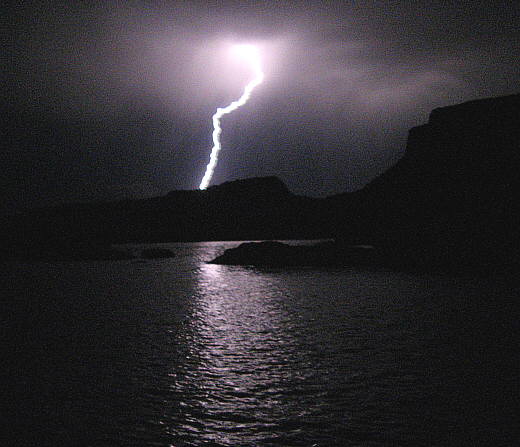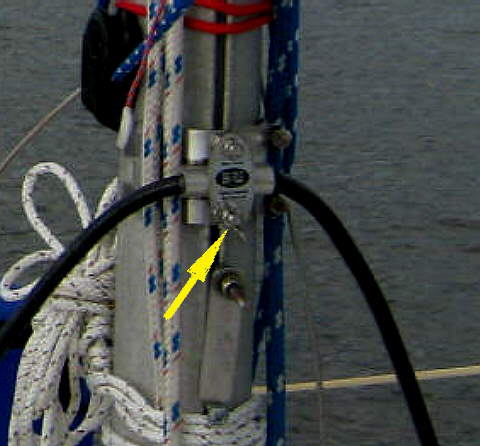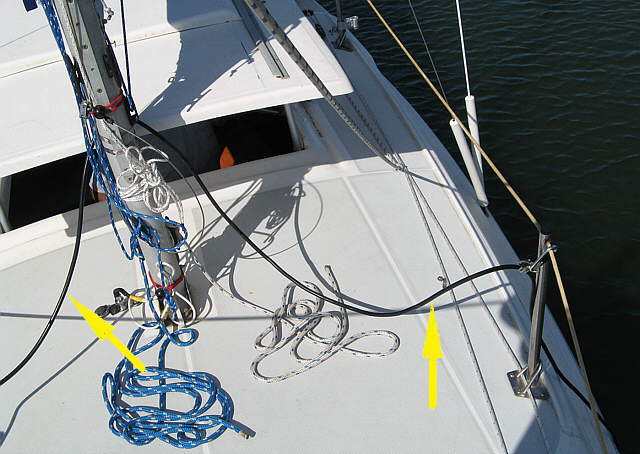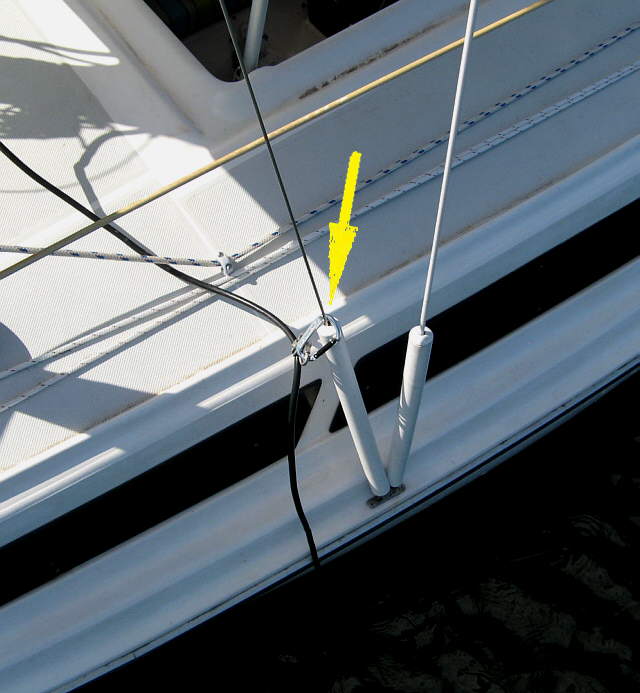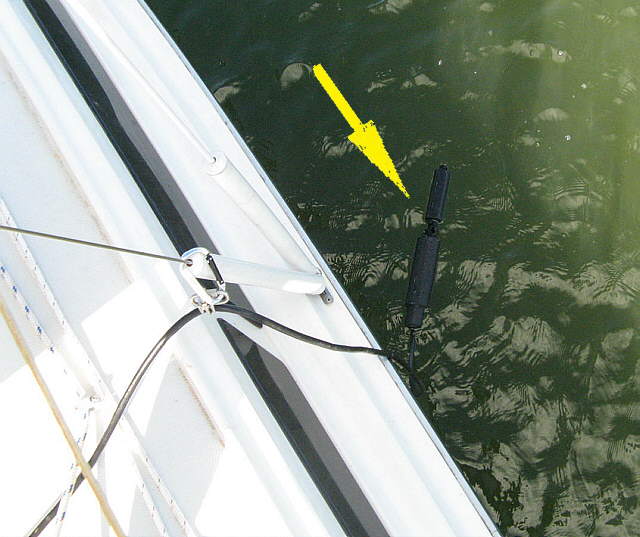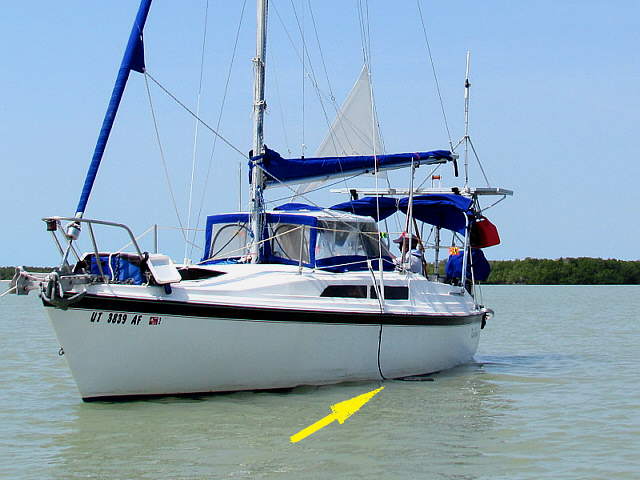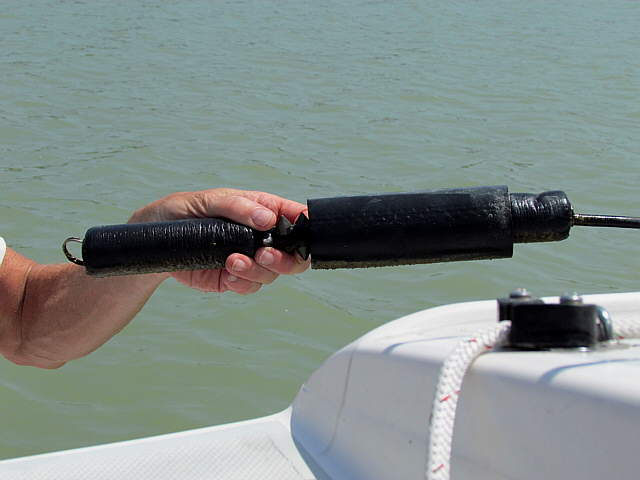...Our MacGregor Index Page....... Mac 26S Outside Mods Index Page..........
....................... Previous Page...................................... Next Page If There Is One
......................................................--- Lightning Protection ---
.............................................................................--- Zen Pole ---
Here is a subject that is about as controversial as you can get. Just Google it and you will see that everyone has an opinion and a reason for their opinion. I'm no different so read along if you care to and take from what follows what you may. If you do decide to install some form of lightning protection on your boat make sure that you are comfortable with the decision you reach.
The Consequences Of Taking a Strike on a Boat:
It seems obvious that no one that has a boat wants to ever get hit by lightning. If you have a boat are you in the same boat with everyone else when it comes to what happens if you do get hit? From what I've read a small power boat is a worst case which might seem strange since they don't have a mast sticky way up there in the sky. Problem is that the occupants of the boat are likely to be the tallest objects in the boat and are what might actually take the strike and the outcome of that isn't good. For us sailors the mast actually offers us some protection as it will usually take the strike. They often refer to a cone of protection coming down from the top of the mast. If you are in that cone then the mast will most likely take the strike and not you.
So we are safer being in a sailboat, but what about different types of sailboats. Statistics say that multi-hull boats are struck more often than single hull boats. Most likely if you are reading this you own a single hull boat and maybe a water ballast boat that doesn't have a steel keel but a non-metallic centerboard or daggerboard. Let's consider for a moment the importance of whether the mast is isolated from the water below or not.
Out Endeavour has what is called a keel stepped mast and the mast goes through the cabin top and through the sole (floor) and rests on top of the keel which is lead. If it is bolted to the keel or bonded to the keel with a strap then hopefully a strike would follow the mast down through the boat and on to the keel and to the water. It might then blast a hole through the fiberglass that encases the keel. A mess, but hopefully it didn't actually blast a hole through the side of the hull and if we were sitting away from the mast hopefully we would also survive.
There are also boats with metallic keels where the mast is stepped to the deck on top of the cabin. If under the mast inside the boat there is a metallic compression post going down to the keel you are still in pretty good shape as there is a path for the strike to take from the mast to the water that might not blow a hole in the hull in an area that could take on water.
If you have a water ballast boat such as our MacGregor S and or the D, X , M or other makes of water ballast boats the situation changes and not for the good in my opinion. If the mast takes a strike the charge has to find a way to the water. One path it might take is down one or more of the stays to the side of the boat or possibly down the backstay or forestay. That would be a better route vs. down the mast, but a less likely route for the strike to take as electricity likes the path of least resistance and the stainless steel rigging has considerably more resistance than the aluminum mast.
Regardless, if the strike goes down the rigging or the mast once it gets to deck level it has to jump from there to the water. Here is where things get ugly. If it jumps from the end of the rigging straight down or away from the boat things look good. If the boat happens to be heeled then it could pass down through the interior of the boat and out the bottom blasting a hole below or above the water line. This obviously isn't good.
Now if the strike goes down to the bottom of the mast since the mast offers less resistance than the rigging things become possibly real bad. Best case for the occupants is that they are sitting far enough from the mast base to escape serious injury. Now the question is will the boat? Once at the base of the mast the most direct route for the strike to take is unfortunately down through the sole and through the water ballast and then out the bottom of the ballast tank where it finally will reach its destination. If it takes this course it is likely that it will blast a hole first through the top of the water ballast tank and then through the bottom of it. If this happens the boat is going to take on water.
For the reasons above I feel, and again this opinion like others here is 'my opinion', that those of us that have water ballast boats stand a greater chance of structural damage to the boat than any of the other sailboat types if we are hit. I'm not saying we have a greater chance of being hit, but that the consequences following a hit could be worse for us.
Will I Get Hit:
If you primarily anchor out and take longer trips you can't plan trips around the weather. That means that sooner or later you will get caught in weather that will probably scare the hell out of you. That has happened with us a couple times. The worst was wind related on Lake Powell, but although it didn't last a long time we were caught in a really bad lightning storm in Canada where we finally left the boat and went ashore with the dinghy to what we felt was better protection. Later we also experience a major...
........................
....lightning storm on a trip on Lake Powell (see picture above), but stayed on the boat for that one and it didn't come as close as the one in Canada.As a result of these experiences I started doing more and more research on lightning and lightning protection for a boat. One of the best resources I've found to this point is an article by NOAA on their web site and I would strongly advise reading it. It isn't that long, but once you read it you can maybe discard some of the opinions that you will find on any boating forum when the topic of lightning comes up. You can find the article ( HERE ). You will find me referring to that article from time to time below.
Does a Lightning Protection Option Actually Attract Lightning:
If you are considering lightning protection you first need to deal with the question/comment that always comes up and that is......if I add protection to my boat will I actually attract lightning? A number of lightning systems incorporate grounding the boat (another topic for discussion, since there is no way to ground a boat in the same manner that your house electrical system is 'grounded). But for sake of argument lets use the grounding term to mean that you are trying to provide a controlled path from the air to water for a lightning strike that hopefully will do as little damage to the boat and its occupants as possible.
So the big question....if I 'ground' my boat will I increase the chances of it being hit? According to what I've read there is no data that proves that boats with some sort of ground on them are hit any more frequently than boats with no 'grounding' (lightning protection). The only figures I've seen in a couple places say that multi-hulled boats are hit more frequently than single hulled boats. If anyone can send me reliable data showing that lightning protected boats are hit more frequently I'd love to see it and will post a link to it here.
If you read the NOAA article you will see that one type of lightning is cloud to cloud. That is no threat to us, so let's move on. Then according to them there are two types of lightning that involve the earth's surface and the clouds above them.
One is called 'natural' lightning and this lightning goes from the cloud to the earth basically. There is a little more to it than that so read the article if you want details.
The other type lightning is called 'triggered' lightning and goes from the ground to the cloud basically. Triggered lightning can occur according to the article in cases of "very tall structures, airplanes, rockets and towers on mountains". So yes grounded objects can at times caused 'triggered' lightning. Now the question is how does our boat with a 30'-50' mast compare to a very tall structure or a tower on a mountain. The tall structure they show in the article looks to be many stories high, much, much higher that any mast on the average sailboat of someone reading this article. Our masts also don't come anywhere near as tall as a tower on a mountain.
The next logical thought is that it isn't very high in reality, but since water is darn flat our mast is the highest thing for quite a ways from our boat. I have to admit that when a lightning storm is near and I look up at that mast I feel that it is just begging to get hit. Again I try to reassure myself that the odds are still low that it will get hit and also fatalities on sailboats are very, very low.
Here is my logic that I use and is a combination of something Walt, who will come into the picture further down the page, said and from the NOAA article. I'll start by paraphrasing the NOAA article. In a cloud to ground strike a negative stepped leader travels down from the cloud to the ground (water in our case) followed by an upward traveling return stroke which is what we see. Now the bad news is that the downward stepping leader can be attracted to a positive charge that is reaching upwards. According to them that could be a tree, house, or telephone pole and we could probably add a sailboats' mast to that list if it has a positive charge. The last doesn't sound so good for us but I don't believe it is as bad as it seems and if you want to take trips with your boat you need to come up with a plan that makes you feel less vulnerable.
So here is what I consider the good news or the 'better news'. The initial negative charge that heads down to the ground does so in what is called a step leader. As it zigzags towards the earth it does so in roughly 50 yard segments in a forked pattern. My thought is that we are only in danger of being hit if out mast is within 50 yards of the last segment as it completes its journey from the cloud to earth. From reading the article I believe, that as the negative leader gets ready to 'touch down' that if the terrain is dead flat it could hit anywhere in a 50 yard radius, but if there is something sticking up in that radius, it is more likely to hit it.
The question now becomes what are the odds of us being in that final 300 foot wide circle where the final step hits the ground after starting its journey to the earth from thousands of feet up in the sky? Now I'd like to relate something I once heard that makes sense to me. Imagine or remember flying in a commercial plane at night over the country side. You look many thousands of feet below and see the lone light of a farm house. Now imagine trying to hit that farm house with a shot that zigzags this way and that every 50 yards. It would be almost impossible and the odds would be very high that the farm house would be safe from any attempt on your part to hit it. I now look at lightning in the same way. That bolt starts thousands of feet above our boat and starts its journey to earth. My only concern is will our boat be within the last 300 foot wide circle where it finally hits. If it is and ours is the only mast or other high object sticking up there then yes we might be hit.
Considering that there was a chance that we could be hit and since I'm not one of the people that believe that we are going to 'attract' lightning to the boat I started looking at the options out there to provide some sort of lightning protection. An article by The University of Florida explains that they don't believe grounded boats are any more likely to be hit vs. ungrounded boats, but ungrounded boats do receive more damage if hit than grounded boats.
Options for Lightning Protection:
Battery Cables in the Water: Clipping battery cables to the mast or rigging or both is probably one of the most common advised solutions on the Internet. I'd considered that until I'd done more research. If you have a ground plate in water according to most sources it needs to be at least 1 square foot in salt water and much larger in fresh water. So putting a 1 square foot plate on the end of #4 copper cable seemed to be a possible solution if we were in salt water, but not much hope for fresh water where we had experienced most of our lightning.
More Complex Options: There are some pretty complex solutions out there that are also quite expensive if you do a simple web search. They seemed too complex and expensive to work or be viable for use with our trailered. MacGregor.
The Zen Pole: About this time Walt who is an electrical engineer and who also owns a MacGregor exactly like ours started to correspond with us about an option that he was developing, which is call the Zen Pole.
Unlike systems that try and take the lightning strike down into the water Walt has developed the Zen Pole system designed for trailered boats. It is meant to take the strike to the water's surface with floating electrodes. The concept of taking the strike charge to the water's surface was previously patented. Walt and his company have licensed this concept from Dr. Thomson, who holds the patent, and have received an addional patent that is based on keeping the discharge electrode at the perfect spot using floatation and a flexible conductor.
Take a second and think about it. Lighting strikes the 'surface' of the water. Look at the third picture down ( HERE ) of the lab simulation of a strike hitting the water and notice that the strike doesn't appear to penetrate the water, but generates discharge patterns above the water surface.
The Zen Pole can be easily attached to the mast and the electrodes left onboard and only deployed over the side when you feel there is a need. The electrodes float on the surface and have multiple side electrodes that stick out from the body. They are located such that some are always just above the surface of the water. This creates a spark gap that the strike will jump across to the surface of the water which is what we want.
We did some field testing of the electrodes for Walt on our 2 trips to Florida in the fall of 2010 and the spring of 2012. We left the electrodes in the water for about 10-11 weeks continuously for the trips, just to gather data on how they would stand up to a salt water environment. They did very well and only gathered some growth on them over time in the water. Those 10-11 weeks would represent years of use as far as exposure to the water since they normally would only be in the water for hours or a day or so at a time. Then there wouldn't even be any growth on them.
Ruth and I feel that considering the different lightning protection systems that are available that this is the one we feel the most comfortable with and also one that can be used on a trailered boat fairly easily. We also plan on installing the same system on our Endeavour. If it works I would rather a strike goes down to the water over the side vs. through the cabin and on to the keel.
Take a minute and visit the Zen Pole site ( HERE ) and study the information there and then decide if you feel that this might be a viable option for lightning protection for you.
Now for some pictures of the Zen Pole installed on our MacGregor 26-S.
.................
Above is the reason we have it. Picture take on a Lake Powell trip in Sept. of 2010.
.................
Sorry about the picture quality. The arrow points to a wing nut that can be loosened and that then releases the cables from the bracket that is held to the mast with hose type clamps. The bracket on the mast can be left on the mast. The cables can come off for transport when the boat is on the trailer or if you only want to put the cables on when you think you might be in a lightning situation. The other option is to leave the cable attached and coil them and the electrode and store them bunged to the mast or on deck in a bag.
.................
Here you see the two cables leaving the mast and going over the side. Above I have them carabinered to the lifeline, but they should be...
.................
...clipped to the highest shroud. That could give you some protection if the strike came down the shroud as it could spark across to the cable as that would be a shorter path than to the water below. Keep in mind thought that there are on complete guarantees when it comes to lightning. We are just trying to do the best we can if we pursue lightning protection.
.................
Here we can see one of the electrodes floating on the port side of the boat. The electrode can be left in the water while underway if needed.
.................
A view from the water and....
.................
... here is one of the electrodes after over 2 months of continuously being in the water. The electrode was left in that long for durability testing. You would only deploy them when you felt they were needed. Note there was some growth on the bottom and I was able to scrub that off.
.....................................................Zen Pole Information Here
